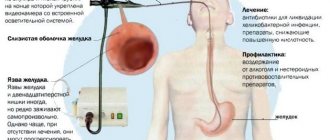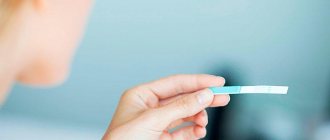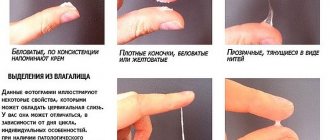What is ovulation
Ovulation is the most important moment in the functioning of the female reproductive system. Ovulation in gynecology means the moment when the egg leaves the ovary and begins its movement along the fallopian tube, where it should meet the sperm. Since the lifespan of an egg is short - no more than 2 days, the period of ovulation is the most favorable moment for conception.
As a rule, during one cycle (lasting from 21 to 35 days), the egg is released from the ovary only once, but there are cases of double or triple ovulation. However, ovulation is a phenomenon that does not happen every day. And that is why many women strive to find out at what point it will come. Is it possible to do this?
Correct use of the test is the key to a successful pregnancy
When purchasing a test at a pharmacy, you do not need to follow what many people do and throw away the instructions for the ovulation test without even reading it. It is in it that the manufacturer points out various subtleties that must be followed in each specific case. For example, many descriptions emphasize the importance of using the test not early in the morning, but in the afternoon. It has been proven that after sleep a woman has the greatest amount of a hormone that is not responsible for ovulation, but indicates pregnancy. It also indicates on which day of the cycle it is more appropriate to use the test and how many times it is necessary to check it in order to obtain reliable indicators.
When applying the test, it is important to take into account what level the strip used should be immersed and how long to wait. For convenience, there are arrows on the test, to the level of which you need to immerse the test for no longer than 10 seconds, otherwise, if these conditions are not met, the error can reach up to 50%.
And you don’t need to check the result of the ovulation test immediately, but after 10 minutes. To do this, you need to put the used strip on a dry surface and let it dry a little. The fact is that the reaction does not have time to fully occur in the first minutes and the second stripe is almost invisible, but appears and becomes bright only after a certain period of time.
How can you determine the moment of ovulation?
Some women may experience certain physiological signs that indicate ovulation is imminent. This may include slight pain in the lower abdomen, slight vaginal discharge, and increased sexual desire. However, all these signs are purely individual and cannot be used as a reliable criterion.
To determine the moment of ovulation in gynecology, various methods can be used:
- Ultrasound,
- measurement of basal temperature,
- measuring luteinizing hormone levels.
Particular attention should be paid to the last method. It is quite simple and at the same time effective, which made it possible to develop a number of tests based on it that can be used at home.
Luteinizing hormone (LH) is a hormone that is synthesized in a woman’s body immediately before ovulation (one to two days). Thus, its increased concentration may indicate that ovulation will take place in the coming days. The highest concentration of the hormone is found in urine or saliva.
Due to this circumstance, several portable systems have been developed to detect hormone concentrations. The chemicals contained in these systems react with LH and make its presence known through visual signals.
Let's consider the operating principle of such systems using the example of a simple strip test. The ovulation test includes several disposable paper strips with a reagent applied to them. It is enough to moisten one such strip in urine, and in a few minutes it will give the result. The appearance of a strip on a piece of paper will mean a high level of the hormone and, as a result, a high probability of ovulation within a few days.
In order for an ovulation test to show the correct result, a woman should follow a few simple rules. Firstly, you should not use the very first urine after waking up for testing. The optimal time for urine collection is from 10.00 to 20.00. In addition, you should not drink a lot of fluid before urinating, as this can dilute the urine and reduce the concentration of the hormone. In addition, repeat testing is recommended to increase the reliability of the results.
Types of testing instruments
Special medical devices for determining the moment of ovulation are freely available, so, if desired, you can purchase any of the devices. They are similar to those used to detect pregnancy. Whatever device is chosen for diagnosis, the woman’s urine or saliva will be required.
There are several types of such products:
- A strip test is an ordinary strip with a reagent that must be dipped into a container with urine. If the content of luteinizing hormone is increased, a second line will appear - it should be quite clearly expressed in color. If the strip has a pale tone, you should continue trying. In just a day or a little more, the egg will mature and be released from the follicle.
- The jet test (express) is the most convenient, since for diagnosis you can simply substitute it under a stream of urine. With a favorable diagnosis, two lines become bright, and you can see the result within 5 minutes.
- The test cassette is considered a more reliable method than a simple test strip. This is a small plastic “pencil case” that has a screen on which you should drop urine, and after a couple of minutes the result will be displayed in another window, that is, two colored stripes.
- An electronic diagnostic device is reusable and provides more accurate information. But it also surpasses the previous options in cost.
- The most highly informative is a digital device that determines the convenient time for conception based on female saliva. The device is shaped like a lipstick, and its internal structure is, in fact, a microscope. Based on a certain specific pattern produced by the biomaterial, the required hormone is identified, which is evidence of ovulation.
Comparing different tests, we can say that they all have some pros and cons. The simplicity of urine strip tests provides quick results without the need to test cervical fluid samples during your period. Moreover, the information is quite accurate, especially when it comes to electronic reusable devices. However, if there is a need to do such tests every month, the method is impractical in terms of monetary costs, and, moreover, diagnostic errors may occur if there are disturbances in the functioning of the genitourinary organs.
If we take the digital method for studying the crystallization of saliva, then it is highly accurate and less expensive for the family.
Women should know that any diagnostic tool only shows the level of the hormone that signals the release of a mature female cell. In order to detect the peak presence of LH, it is necessary to test at least twice a day so as not to miss it.
Ways to use ovulation tests
What can an ovulation test be useful for? Firstly, it can be useful for women who passionately want to get pregnant. After all, ovulation and the few days preceding it are the most favorable period for conception.
Some women use tests as a means to plan the sex of their child. There is a theory according to which sperm carrying the male chromosome are less tenacious, but more mobile compared to sperm carrying the female chromosome. Therefore, the closer to the moment of ovulation sexual intercourse was performed, the greater the chance that the egg will be fertilized by a male sperm.
In other cases, an ovulation test can be used by women who, on the contrary, want to avoid pregnancy. After all, after two days after ovulation, sperm will no longer be able to fertilize the egg. However, this method requires more frequent testing, and given that test strips cost some money, it is associated with some material costs. In addition, this method of protection cannot be called very reliable. After all, ovulation tests report only the concentration of LH, and not the moment of ovulation itself. Not to mention the high probability of obtaining false negative results due to non-compliance with the testing methodology or poor-quality (expired) test strips.
What do you need to consider?
Every woman who is going to use the test needs to take into account some nuances:
- Before using the test, you must carefully read the instructions and be sure to follow the manufacturer’s recommendations;
- to increase the reliability of the result or if there is a small difference in the length of the menstrual cycles, it is necessary to regularly measure the basal temperature;
- an ovulation test should not be used while taking any hormonal drugs - even external use of ointment with steroid hormones prescribed for the treatment of allergies reduces its reliability ;
- hot weather and taking large amounts of liquid significantly distort the result - the amount of urine increases, and the concentration of LH decreases even against the background of ovulation, which the test will reflect as a false negative result;
- If you follow the manufacturer's recommendations, a positive test result means that within the next 48 hours (from the moment the first positive result is received).
If pregnancy is desired, then the probability of its occurrence is the highest, while contraceptives will help to avoid fertilization of the egg - If you have an irregular cycle, rely on a test to prevent pregnancy. Carrying out a test every 12 hours on the days of expected ovulation helps to accurately identify its moment - that is why the package contains 5 test strips;
- morning urine is not suitable for testing (as opposed to home pregnancy tests). Before collecting urine, you must refrain from emptying your bladder for 4 hours;
- a test with damaged individual packaging, exposed to a humid environment or contaminated is not suitable for determining ovulation.
How does pregnancy proceed after birth control pills?
And here you will learn about how to take angiovit when planning a pregnancy.
You can learn how to identify an ectopic pregnancy here.
Types of testing systems for PH
In total, the pharmaceutical industry produces several testing systems:
- using disposable strips,
- using disposable cartridges,
- jet systems,
- electronic devices with disposable strips,
- optical instruments for determining LH from saliva.
Testing with disposable cartridges is much like testing with strips. The only difference is that a drop of urine must be dropped into one window of the cartridge, and the result will be displayed in the other window.
The device with disposable strips is similar in principle to devices for testing blood sugar levels. A strip soaked in urine is inserted into a special connector, and the test result appears on the indicator. Read on the official Frautest website about what types of ovulation tests exist.
How to do tests correctly
The study can be done at any time of the day, but it is advisable to stick to the same period of time every day. This test should not be performed with the first portion of urine in the morning, since intense hormone synthesis begins only after 10 am.
There are different tests that differ in appearance, names and other parameters. More often than others, there are ordinary test strips that resemble pregnancy tests in appearance.
This test strip is a paper strip on which a reagent and a control line are applied. It is immersed in urine for a few minutes and then the test result is assessed.
To understand what the test result showed, you need to compare the color of the test and control lines. If the result is positive, then the second strip is darker or the same color as the control line. If the color is paler or the second stripe does not appear, then the test result is negative and you need to continue testing.
The ovulation test is positive on the 16th day of the cycle.
Carrying out an ovulation test, instructions
Let us describe in more detail the method of testing for PH using disposable strips (strip tests). The most popular ovulation tests of this type are produced under the brand names Frautest, Eviplan, Solo.
Typically, an ovulation test includes several strips for testing for LH. Some also come with additional pregnancy test strips.
Test strips are removed from the packaging immediately before testing; they should not be stored unpacked. To start the test, place the urine in a clean and dry container. By the way, many kits are equipped with special containers for urine. Then the strip should be immersed in the urine for about 5 seconds, then pulled out and placed in a dry place.
Normally, the test strip should be white. After a few minutes (it’s better to check the instructions for the exact time, but usually no more than 10 minutes), the strip may change its appearance.
Possible options for changing the strip:
- there are no lines - poor quality or expired test;
- only one (control) line appeared - no LH;
- one line appeared and next to it a pale second line - there is no LH or its concentration is very low;
- a control line appears, as well as a second line, darker than the control line or of the same intensity as it - a high concentration of LH, ovulation should be expected.
Contraindications
There are no absolute contraindications to the use of ovulation tests; each of them works without causing harm to health. However, under certain conditions their use is useless:
- If you are already pregnant. Even in the early stages, such tests are not carried out.
- During and after menopause. A woman’s reproductive ability declines, ovulation in old age is rare, and usually the hormonal levels change completely.
- While taking hormonal medications. Some medications are used for contraception, others to treat gynecological diseases such as polycystic disease.
If there are none of these contraindications and the test is negative, you should consult a doctor. Perhaps there is no ovulation at all. If it is late or there is any other menstrual irregularity, you should not delay it. Sometimes there is such a thing as two ovulations in a row, if this happens constantly, it is also necessary to undergo diagnostics.
The variety of existing ovulation tests allows each woman to choose the appropriate option for herself and monitor the progress of the menstrual cycle. It is important to study the instructions for use and, if necessary, consult a gynecologist. Among the advantages of such devices are accessibility, information content and practicality.
https://youtu.be/LM-rqbsZCmI
Optical testing systems
Special mention should be made about optical systems that determine the concentration of LH not in urine, but in saliva. They are essentially small microscopes designed to examine droplets of saliva. Analysis results in some of these devices can be provided automatically. In other devices, it is necessary to manually compare the pattern visible in the eyepiece with the template. It has been found that in the case of high levels of LH, a certain structure becomes visible in saliva under a microscope, similar to a tree leaf or a snow crystal. In general, optical instruments are considered more reliable than systems based on chemical urine testing. In addition, they are much more convenient - after all, it is not always convenient for a woman, especially a busy one, to carry out some manipulations with urine. The disadvantage of such devices, however, is their high price. However, given that devices of this type are reusable, they can be cheaper than traditional strip tests.
Operating principle
Ovulation is a physiological process that occurs in a woman’s body. Immediately after menstruation, one or two new eggs begin to mature in the ovaries. Then the mature egg is released, which is accompanied by hormonal changes in the body.
The principle of operation of modern ovulation tests is to detect luteinizing hormone. It appears during the release of a mature egg not only in the blood, but also in other biological fluids of the woman’s body, in particular urine and saliva. Most test systems that are available on the modern pharmacological market are designed to determine the presence of luteinizing hormone in a woman’s urine.
Thus, this device helps a woman get pregnant faster. Determining the level of LH in urine makes it possible to plan the optimal date for fertilizing sexual intercourse. This way, the chances of pregnancy will be much greater than with spontaneous intimate contacts without taking into account the date of rupture of the follicle and the release of the egg from it.
When should you start testing for ovulation?
You can, of course, carry out the test every day throughout the menstrual cycle, but in most cases this is irrational from a financial point of view (one test strip costs at least 60 rubles, and with an increase in quality, and as a result, accuracy, its price, naturally , increases). Therefore, most women calculate the approximate time of the onset of ovulation. As a rule, ovulation occurs in the middle of the menstrual cycle. That is, if a woman’s cycle is normal and lasts 28 days, then ovulation usually occurs on the 14th day. The first day of the cycle is the day the menstruation begins.
However, the exact time of ovulation is impossible to predict (otherwise there would be no need for any tests). The following factors may influence the timing of ovulation:
- infectious diseases,
- psychological and emotional state of a woman,
- changing weather conditions.
Also, the time of ovulation may be “off” after childbirth, abortion, or when menopause approaches. It is for this reason and because it is best to know about ovulation in advance, it is best to start testing a few days before the expected date of this event. Most experts recommend starting testing on the 11th day of your period. In this case, you can conduct not one test per day, but two, every 12 hours. If the cycle length is more than 28 days, then it is recommended to start testing 17 days before the start of the next menstruation.
If a woman’s cycles have different durations, then it is necessary to focus on the shortest cycle. That is, if a woman has cycles of 26 and 32 days a year, then it is better to assume that the expected day of ovulation is the 13th day. Or you can subtract 17 days from the minimum cycle and start testing from that day.
When should you take an ovulation test?
If a woman’s menstrual cycle is stable, which is equal to the standard 28 days, it is recommended to carry out the procedure starting from the 11th day. It is not difficult to make your own calculations. You need to subtract the number 17 from the total duration of the cycle.
It also happens that a woman’s menstrual cycles have different durations. In such a situation, the shortest of them should be determined over six months. It is he who will be taken into account in order to detect ovulation. The remaining actions fully comply with the above recommendations.
If the cycle is extremely unstable, and delays between menstruation can reach several weeks, it would be most rational to think about additional research regarding the onset of ovulation. The use of home tests alone in this case seems to be a completely unjustified decision. It is better to resort to periodic ultrasound examinations, which will definitely not allow you to miss the right time to conceive a child.
Determine the average length of your cycle over several months. Find in the table below in the first column the length of your cycle - in the column opposite is the cycle day (DC) on which you should start testing.
| Average cycle length | Start of testing (DC) |
| 22 | 6 |
| 23 | 6 |
| 24 | 7 |
| 25 | 8 |
| 26 | 9 |
| 27 | 10 |
| 28 | 11 |
| 29 | 12 |
| 30 | 13 |
| 31 | 14 |
| 32 | 15 |
| 33 | 16 |
| 34 | 17 |
| 35 | 18 |
| 36 | 19 |
| 37 | 20 |
| 38 | 21 |
You can calculate this day yourself by using the cycle length formula - 17. As soon as the ovulation test shows a positive result, you can stop testing.
Is testing always reliable?
In what cases are false positive tests possible? LH levels may increase not only due to upcoming ovulation, but also due to ovarian depletion syndrome, hormonal dysfunction, renal failure, and postmenopause. Also, the level of the hormone is highest in the morning - which is why it is not recommended to take the first morning urine for testing. In addition, tests can also respond to increased levels of thyroid-stimulating hormone, as well as to phytohormones that can enter a woman’s body with food.
All this suggests that relying only on tests is not the wisest decision. Other diagnostic methods, such as ultrasound, are more reliable than rapid tests.
Is it possible to do this test to determine the gender of the unborn baby?
It is impossible to influence this factor. However, there is a theory according to which conceiving immediately after ovulation increases the chances of conceiving a boy, and the later the ovulation, the greater the likelihood of conceiving a girl.
Thus, if a couple dreams of a boy, then sexual abstinence until a positive test result increases the chances of conceiving one. And if a couple is thinking about a girl, then it is advisable to make love a day or two before expected ovulation. This method may have its place, but it cannot guarantee the couple an accurate result.
An ovulation test is an excellent assistant for spouses when planning a long-awaited child. When carried out correctly, it shows an accurate result and helps determine the favorable time for conception.
https://youtu.be/UgFYeIURDdc
Similar articles
Review of the best ovulation tests and how to use them
11 awkward questions about ovulation tests
How to use the Clearblue Digital Ovulation Test correctly
What does knowledge of hCG give in IVF?
Necessity
So, we looked at how the ovulation test works. What is it for? When a woman is planning a pregnancy, she must remember that in each cycle there is a limited number of days fertile for fertilization. The most effective are just a couple of days during which ovulation occurs, and they are different for each period. Diagnostic devices help identify them.
Many methods for determining the right time for the birth of a new life are either ineffective (for example, a system for measuring basal temperature) or require examination in a hospital (in particular, an ultrasound scan or a blood test). It is known that digital tests (for example, Clearblue) provide research accuracy of up to 99%. Thanks to them, women feel confident at every stage of the test.
Many people are interested in how the ovulation test works. If you want to identify the beginning of the reproductive period, you need to have information about your body and the menstrual cycle. To determine the duration of the cycle, you need to calculate the number of days from the first day of menstruation to the day before the start of the next menstruation. The duration of this period varies significantly for most women, but very often it is 23-35 days. The middle of the cycle is considered the most productive. The exact time can only be determined through research.











